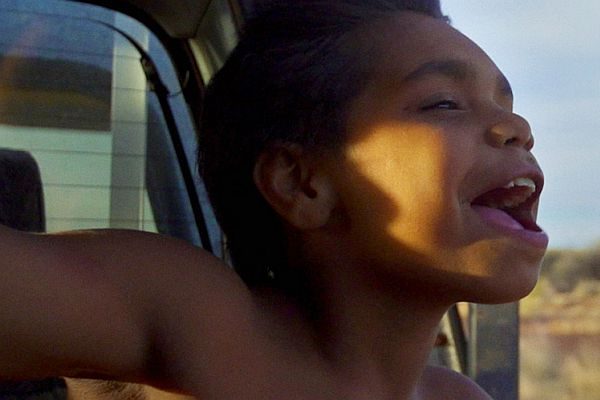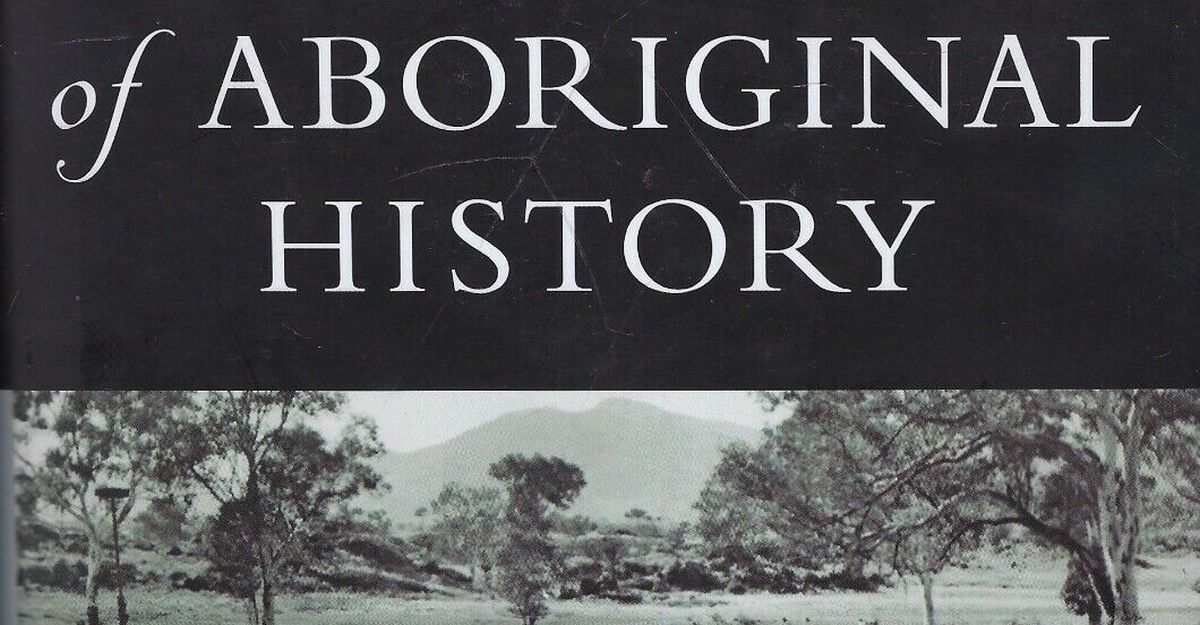In My Blood It Runs was shot in Mparntwe, Sandy Bore Homeland and Borroloola Community, in the Northern Territory. It is the story of a boy called Dujuan, a child-healer being trained in the ways of the Arrernte people and a good hunter who speaks three languages. The documentary shows him getting into trouble at school and risking incarceration.
Skilfully woven into the film is archival footage of traditional owners throughout history. But even more affecting is the inclusion of more recent news footage. As Dujuan comes of age in an Alice Springs where police patrol the streets locking children into paddy wagons, the results of an inquiry into the Northern Territory’s juvenile detention systems are released, its findings devastating. Aboriginal youths are being tortured in custody. By being out after dark, Dujuan risks being locked up in the very facilities the inquiry has found to be in violation of basic human rights –and he is ten years old.
Since the film’s release, Dujuan’s message of self-empowerment and his demands for justice for Aboriginal people have been heard in various governmental settings. Dujuan addressed the United Nations about the issues Aboriginal people face in their own country. He also wrote an article for Overland.
In June, The Guardian recorded that have been 437 Aboriginal deaths in custody in Australia since 1991. There have been more since. In My Blood It Runs offers something we desperately needed: not only a coruscating critique of the discriminatory judicial and educational systems that brutally torture and kill Aboriginal people, but the articulation of what a more constructive way forward looks like: a path towards community, and towards healing.
The documentary is also significant because of its radically collective production process. The filmmaking teams’ approach deliberately decentralises the non-Indigenous filmmaker/exoticising voyeur’s gaze, placing Dujuan in control of his own narrative, and his community in control of its own stories. I spoke to filmmakers William Tilmouth, an advisor of Arrernte descent, Maya Newell, a director and producer who previously made the award-winning Gayby Baby, and Rachael Nanninaaq Edwardson, an acclaimed Iñupiaq/Norwegian/Sami filmmaker, about their technique for actively re-distributing power.
It’s important to note here that though it’s a tendency of the mainstream press to read the non-Indigenous (to that land) filmmakers as the initiators and drivers of this project, the seeds of In My Blood it Runs were sewn by the Arrernte community. Having seen Newell’s work, they approached her about ten years ago with an invitation to film their stories. The re-distribution of power that the team aspired to stemmed from an awareness, Edwardson said, that ‘we’re the ones that were standing up and getting the money, we’re the ones that are holding the camera, we’re the ones that could easily say: ‘Sign this release form and then you give us rights to everything you have,’ which is how a lot of films get made.’
And she’s right. This is anecdotal, but when I lived in the indigenous community of Wingellina/Irruntyju, the white-run media company in the town, under pressure to tick boxes and send completed material back to funding bodies, often reverted to a straight-up dictatorial approach. Tilmouth references this style of non-Indigenous led filmmaking in this region of Australia. ‘Directors have clear ideas about how they want to portray Indigenous communities,’ he says. ‘They come in with absolutely prescriptive directives, like: ‘We want you to do this, can you learn your lines and sit still and then we’ll cut to you.’ The team behind In My Blood it Runs never did that. ‘The filmmakers never came in with a script. They never came in with a storyboard … It was organically driven and a credit to the filmmakers.’
But as idealistic and ethical this approach appears to be, how possible is it to share power in this way in a truly collaborative process? In white-dominant country, where Dujuan and his community represent one of the lowest socio and economic groups, where the language needed to secure funding for something as ambitious as a full-length documentary is most emphatically English (a second or third language for many Indigenous people of that region), and where non-Indigenous filmmakers are wielding the tools of the story-making itself, how possible is it really to overturn the non-Indigenous gaze?
Setting aside the flawed notion of an unbiased documentary-maker, and accounting for the subjectivity with which any story on screen will be shaped, even the most well-meaning crew of non-indigenous filmmakers – by virtue of their function and positioning – risk re-inscribing the same old white-dominant narratives. What could a real collaborative process look like in a landscape where colonial injustices never ended, and just continued under different names? How could a non-indigenous filmmaking team walk into such an unequal playing field, and effectively give the power back to the communities who never ceded their lands?
This is how.
Firstly, this was an Arrernte-led project whose impetus came from the community and from Dujuan himself, who serves as both our point of view and protagonist. The beginning of the documentary shows us whose hands the camera is in: Dujuan’s. He interviews his mother through a handheld screen. It’s an image that is also to be referenced in the final shot. We are invited in and ushered out by the community, for the community, and the responsibility for the shape of the film, finally, it is implied, lies in the communities’ hands.
As Newell says from the outset, Dujuan was a special kid. A kid who wanted to share his stories and be filmed. Such is his generosity, in fact, that he shares with us not just his prowess in healing and in traditional forms of knowledge, but also his struggles. At one point in the film Dujuan – who is having difficulty with a curriculum that is teaching him that Captain Cook discovered Australia, implemented and assessed in English by teachers who flagrantly ignore his questions – gets a school report. I watched this documentary with my nine-year-old son. As Dujuan’s mother opened his report, I told him Dujuan had been given the same tests as he had: that it was the exact same curriculum my son was being assessed with. What he saw next made him cry.
The willingness to share such experience and stories has to be community-led, not the other way around.
Secondly, the crew that was asked to film this communities’ story started with a question. Edwardson, herself a First Nations Iñupiaq/Norwegian/Sami person of Alaska, said that form the outset her question was: ‘We have a group of filmmakers, none of whom are indigenous to this particular country, are we even the right people to make this story?’ That fundamental question fed into how they envisioned and eventually undertook the project, which took a total of three years of filming. ‘Our North star,’ Edwardson says, ‘was making sure that we were making a film where we made space in some way for the community to control and be proud of [it] in the end; that it was a true collaboration … The trust would come if we got that part right, because that’s the hardest part to get right.’
Thirdly, the crew began with the acknowledgment of its bias. This goes against antiquated notions of documentary filmmaking, where the crew are some kind of apolitical force behind the camera. Edwardson emphasised ‘the imbalance of power and the understanding of the bias that we all carry as being raised by systems that maintain bias, so we are all subject to that until we actively try to dig that out of our worldviews and … modes of operation.’ The filmmakers actively engaged with their own biases. What this looked like in practical terms was training for everyone who was non-indigenous.
‘There’s that process of consciously setting up and training non-indigenous people in our team, and talking through the stereotypes that exist in the grand narratives that we have about First Nations people in this country,’ Newell said. ‘That allows you to have the armour to be able to face pulling them apart because everything around us tells you to tell the story in a certain way. You’re asked constantly by media to frame the story in a particular way.’
Fourthly, the team assumed and went about educating themselves to increase their cultural competence. It researched widely and hired cultural advisors, five of whom are listed in the film’s credits. And it made the community members collaborative producers: partners.
Aside from looking at the processes of peak bodies in Australia, such as Screen Australia’s protocols on indigenous filmmaking, the producers leaned on work that forms cultural safety models in Aotearoa New Zealand, and translated those protocols into filmmaking. They used ‘those two foundational pillars of cultural safety which are applicable across any space,’ Edwardson said. ‘One to understand your bias, and the power imbalance and the power in the system, and … to then increase your cultural competency alongside that. And the other is obviously to give agency over to the family and the clients and the people who are most affected.’
How did that look in practice?
With every new chunk of filming, the team went back to the community, who always retained its role as editor and shaper of its narratives. Edwardson says that although the story ‘features one boy and one family story at the front of it,’ it was taken to community meetings. The community, family and advisors saw the rushes, the raw unedited visuals and sounds from the day’s filming. Edwardson says ‘even before the rushes they did the story workshop, we did story workshops with them where we storyboarded, and we played around with ideas about how we were going to cover things, what things to cover, what things maybe not to cover, whether or not we collect this and deal with it later … at every step of the way. So the community had a hand in what that story went out.’
Newell and Edwardson both readily admit to the mistakes they made along the way. But it’s this kind of self-reflexivity that made them suitable guardians of these stories.
In white-dominant Australia, where children are seized and incarcerated and tortured, and where generation after generation of Aboriginal people are failed at school, discriminated against, locked up, and killed, In My Blood it Runs offers a both a working model for engagement and a possible way forward. Tilmouth talks about his people as people who are often prescribed inappropriate ‘solutions’. Solutions which he says are harmful and which are ‘dreamt up by people who know nothing about them.’
The only way forward is the kind of robust process used by this team. And most importantly, Newell emphasises that the only ‘solution’ for Dujuan finally in solving the problems and the threats he faces, comes from his family and from his community itself.



